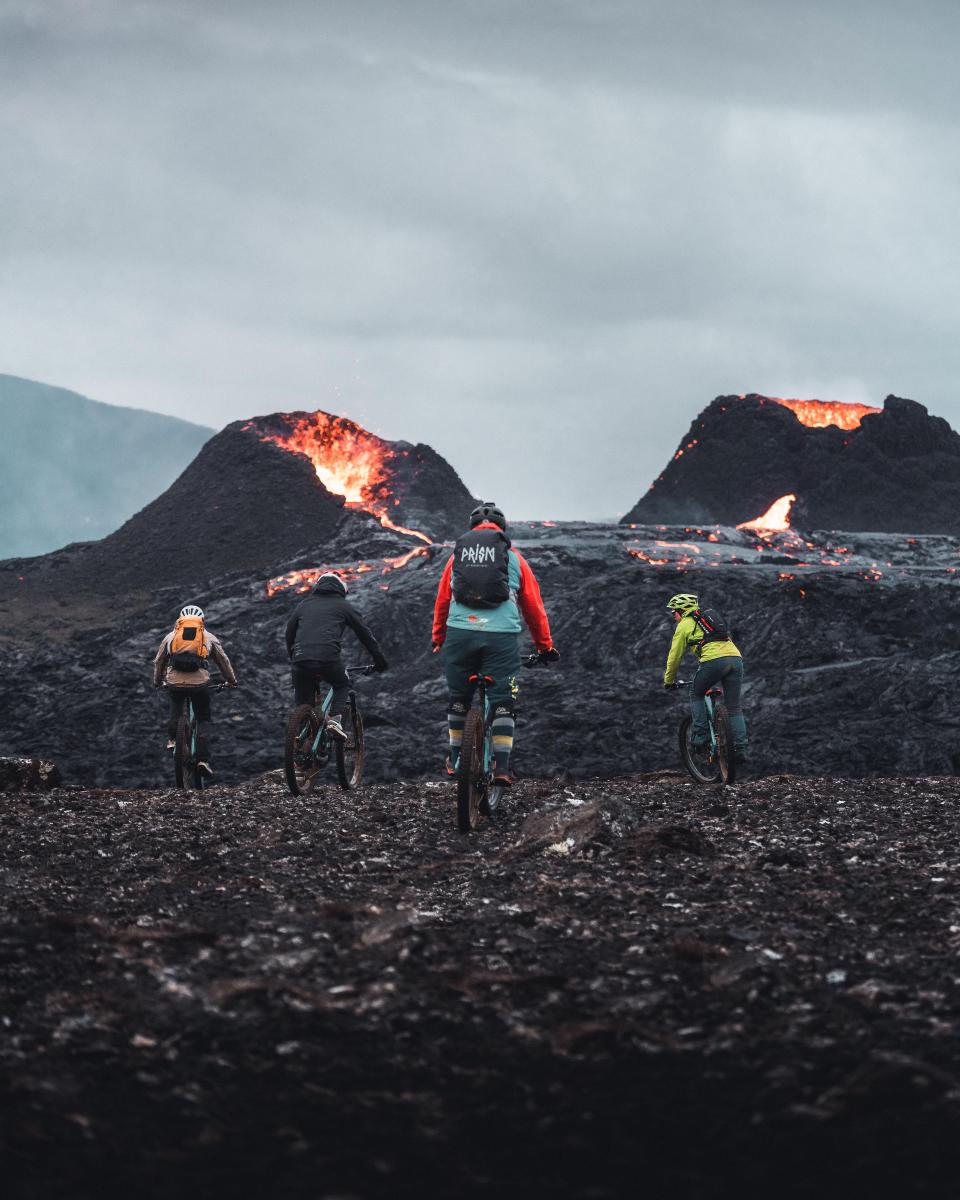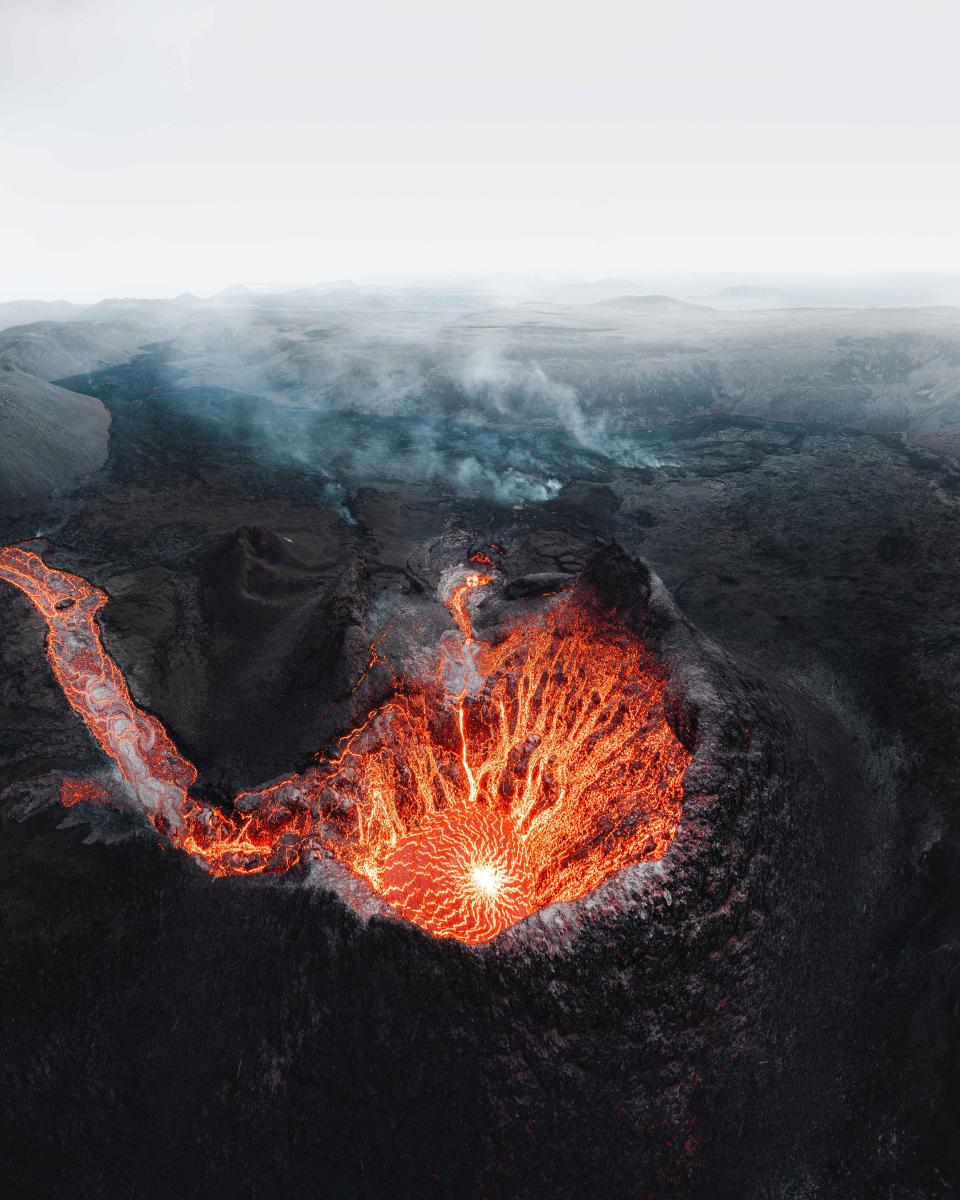Iceland's Volcanic Eruption Has Become a Reason to Party
Our Here, Now column looks at trends taking hold in cities around the world and gives you the low-down on how to experience them the next time you're in town.
“It felt like a music festival,” says Tomas Gustafsson, a college student who has traveled to Iceland twice since the spring.
He was in Iceland on day four of the eruption of the Geldingadalur volcano, to witness the crater spewing out bright red, bubbling lava onto the rocky valley below. Gustafsson expected to see a mind-blowing natural feat—an eruption hadn’t occurred in this part of the country, the Reykjanes Peninsula, in 782 years, after all—but what was less anticipated was the bustling social scene he would encounter.
“There were all these cars parked on the street, and tons of people were just walking toward the volcano,” he says. “We grilled hot dogs on the lava and drank beer. We met the people around us, and some said they had heard groups singing Icelandic folk songs. Everybody was so happy, like they couldn’t believe they were there.”
In Iceland the volcano, which started erupting on March 19th and is still going, has become a reason to party. At the site locals and tourists, vaccinated and emerging from lockdowns, are eating, drinking, and mingling with strangers. Vendors, including one selling fish and chips, have set up shop to feed hungry revelers. “There was this one guy selling lamb soup out of his trunk,” says Danny Manzouri, a New Yorker who held his bachelor party in Iceland at the end of June. “He was cleaning up.”
To no surprise, the tourism industry is benefitting from it, too. “We joke that we are having our own version of the Fyre Festival,” says Ryan Connolly, co-owner of Hidden Iceland, a tour company known for small, personalized trips. (With none of the implications that name brings, of course; though the nickname is undoubtedly catchy.) He has visited the volcano around 15 times since it began erupting—and his company has brought more than 300 Americans since mid-May.

Iceland Volcano, 2021

Iceland Volcano, 2021
From March—when the Geldingadalur volcano started erupting—through June, visitors could get within 500 feet of it via a walking path, says Connelly. Though cold temperatures across Iceland typically prevent people from staying outside for extended periods of time, even in the summer, that proximity to the lava delivered enough heat to keep visitors there for hours. Connelly went with his friend Simon who was celebrating getting his master's degree. “He brought about six bottles of champagne,” says Connolly. “Everyone was popping bottles.”
Lava has since covered that access path—which required a two-and-a-half hour walk from start to finish—and now, visitors can only see the crater from afar, after taking a steep, strenuous hike up a mountain along one of several alternate routes. (A new lava flow field that formed at the end of July is also accessible, by a two-hour walk.) The new routine is to make the big climb to see the volcano’s crater—and to then spend the night celebrating in bars, restaurants, hotels, and even lagoons afterward.
Given the intensity of the hour-and-a-half-long hike, Manzouri had assumed his group of nine would go straight to bed after leaving the volcano at 1 a.m. Instead, thanks to an adrenaline high, they stayed out until 5 a.m. “We went to this club called Sólon and got bottle service and toasted to the volcano,” he says. “We were so proud of ourselves for making it.” Strangers came over to share their own volcano stories over shots.
Even at some of Iceland’s most interesting destinations, people are talking about the volcano. OX is a hidden restaurant in Reykjavik that only serves 11 people two nights a week. Diners get a 16-course tasting menu, paired with wine, full of interesting, local varieties of fish, meat, and produce. While tipsy diners used to ramble on about the food, they now talk about the eruption. “They are most impressed with the volcano,” says chef Thrainn Freyr Vigfusson.
At the Sky Lagoon, a new geo-thermal spa in Reykjavik that opened at the end of April, tourists and locals are comparing notes of what they saw while lounging in the thermal pools overlooking the sea. “I was looking out at the water in the sauna, and one of my friends mentioned the volcano," says Connelly. "Three tourists [near us] were like, ‘What is it like? How do we get there?' It’s always on the tips of people’s tongues.”
It’s not just in Reykjavik, either. At a seaside restaurant named Bryggjan in Grindavík, a fishing village about a 10-minute drive from the volcano, the owners now show a volcano live stream on a large screen. People sit there for hours, eating their famous lobster soup and drinking beer, while watching. It's hard to pin down just what makes this eruption such a big deal—though a number of converging factors seem to be working in its favor.
First, Geldingadalur is safe to visit. Unlike recent eruptions including E15, a volcano in the south of Iceland who grounded planes in Europe for a week in 2010, this one is effusive—or, hardly explosive. “The ground in this area is already cracked or fragile, so it’s easy for the lava to find places to escape without a big explosion,” Connolly says. The lava flows gently, more like a stream, so it's safe to get close. (Though local officials still monitor conditions including gas levels should the site become unsafe for humans.)
Here's what's open—and what's not—for American travelers.
It’s also rare for an erupting volcano to be so conveniently located. Geldingadalur is a 45-minute drive from Reykjavik, a 30-minute drive from the airport, and a 15-minute drive from the popular Blue Lagoon. “It couldn’t be at a better place from a tourist standpoint,” Connolly says.
The party atmosphere is fueled by the country’s current 24 hours of daylight, something tourists and locals report gives them energy and stamina. “You just don’t even feel that tired,” Manzouri says. “The sunlight keeps you up.”
Then there’s the reality that, as more people get vaccinated and feel comfortable going out (for now, at least), they're eager to experience everything, especially something so unusual, on offer.
“This volcano erupted after everyone had undergone a long period of isolation,” says Connolly, and it’s just not clear how long the eruption will continue. “It could be 10 minutes, two weeks, two years, or an entire lifetime,” he says. “We just don’t know, and nobody wants to miss their chance to get back into the world and celebrate something amazing.”
Originally Appeared on Condé Nast Traveler


